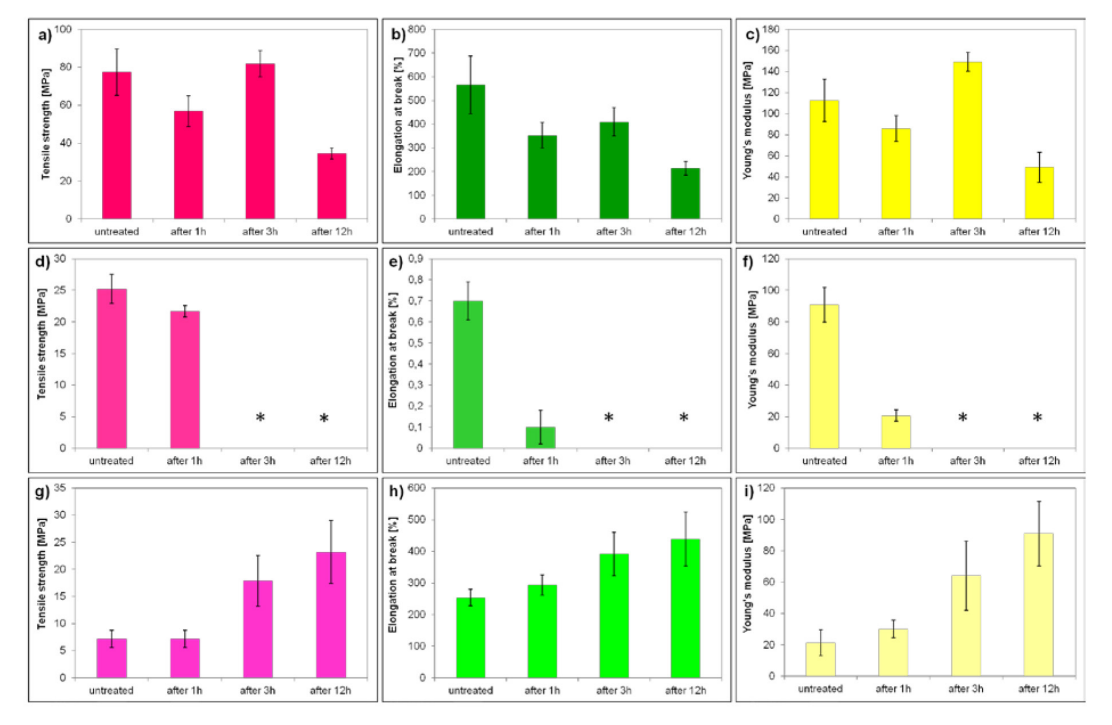Hydrogen peroxide/UV treatment on polylactide/polyurethane blends for biomedical applications
DOI:
https://doi.org/10.5604/01.3001.0010.7552Słowa kluczowe:
hydrogen peroxide, UV irradiation, polylactide, polyurethane, surface modification, wettability, morphology, mechanical propertiesAbstrakt
Biodegradable polymers should be non-toxic, possess low immunogenicity and good mechanical properties. Due to their hydrophobicity and their low surface energy cells only poorly attach, spread and proliferate on these biodegradable polyesters. Therefore, the surface of these polyesters should usually be modified and already several approaches have been presented to increase their cell affinity. In this research the influence of hydrogen peroxide combined with ultra violet irradiation on wettability, morphology and mechanical properties of PU/PLA blends as well as their pure components. It was clearly visible that both pure PU and PLA acted completely different form PU/PLA blend during treatment. The wettability of pure polymers changed after H2O2/UV, PU surface became more hydrophilic, whereas PLA becomes slightly hydrophobic. Due to micropores and microcracks visible on surfaces resulted from breaking ester linkage, deterioration of their mechanical properties was also observed. The exposure of PU/PLA films to H2O2/UV irradiation showed the change of wettability toward more hydrophilic and increase of mechanical properties because of specific affinity to the etching process.
Statystyka pobrań
Bibliografia
Y. Ikada and H. Tsuji, Macromol. Rapid Commun., 2000, 21, 117–132. Google Scholar
J. C. Middleton and A. J. Tipton, Biomaterials, 2000, 21, 2335–2346. Google Scholar
P. A. Gunatillake, R. Adhikari and N. Gadegaard, Eur. Cells Mater., 2003, 5, 1–16. Google Scholar
I. Vroman and L. Tighzert, Materials (Basel)., 2009, 2, 307–344. Google Scholar
L. S. Nair and C. T. Laurencin, Prog. Polym. Sci., 2007, 32, 762–798. Google Scholar
H. Shen, X. Hu, F. Yang, J. Bei and S. Wang, Biomaterials, 2007, 28, 4219–4230. Google Scholar
L. H. Chan-Chan, R. Solis-Correa, R. F. Vargas-Coronado, J. M. Cervantes-Uc, J. V. Cauich-Rodríguez, P. Quintana and P. Bartolo-Pérez, Acta Biomater., 2010, 6, 2035–2044. Google Scholar
Q. Liu, L. Jiang, R. Shi and L. Zhang, Prog. Polym. Sci., 2012, 37, 715–765. Google Scholar
Z. Zhang, R. Kuijer, S. K. Bulstra, D. W. Grijpma and J. Feijen, Biomaterials, 2006, 27, 1741–1748. Google Scholar
P. Mainil-Varlet, B. Rahn and S. Gogolewski, Biomaterials, 1997, 18, 257–266. Google Scholar
H. S. Azevedo and R. R. L. Reis, Biodegrad. Syst. tissue, 2005, 177–202. Google Scholar
A. G. M. Lu, Lichun, Charles A. Garcia, J. Biomed. Mater. Res., 1999, 46, 236–244. Google Scholar
M. Meek, K. Jansen and R. Steendam, Res. Part A, 2004. Google Scholar
T. Xi, M. Sato, A. Nakamura and Y. Kawasaki, 1994, 28, 483–490. Google Scholar
A. C Albertsson and M. Eklund, J. Appl. Polym. Sci., 1995, 57, 87–103. Google Scholar
Q. Liu, J. Wu, T. Tan, L. Zhang, D. Chen and W. Tian, Polym. Degrad. Stab., 2009, 94, 1427–1435. Google Scholar
N. Murthy, S. Wilson and J. C. Sy, Polym. Sci. A Compr. Ref. 10 Vol. Set, 2012, 9, 547–560. Google Scholar
T. Desmet, R. Morent, N. De Geyter, C. Leys, E. Schacht and P. Dubruel, Biomacromolecules, 2009, 10, 2351–2378. Google Scholar
Z. Ma, Z. Mao and C. Gao, Colloids Surfaces B Biointerfaces, 2007, 60, 137–157. Google Scholar
J. M. Goddard and J. H. Hotchkiss, Prog. Polym. Sci., 2007, 32, 698–725. Google Scholar
G. H. Koo and J. Jang, Fibers Polym., 2008, 9, 674–678. Google Scholar
M. H. Ho, J. J. Lee, S. C. Fan, D. M. Wang, L. T. Hou, H. J. Hsieh and J. Y. Lai, Macromol. Biosci., 2007, 7, 467–474. Google Scholar

Pobrania
Opublikowane
Jak cytować
Numer
Dział
Licencja
Prawa autorskie (c) 2017 Państwowa Wyższa Szkoła Zawodowa w Tarnowie & Autor

Utwór dostępny jest na licencji Creative Commons Uznanie autorstwa – Użycie niekomercyjne 4.0 Międzynarodowe.



